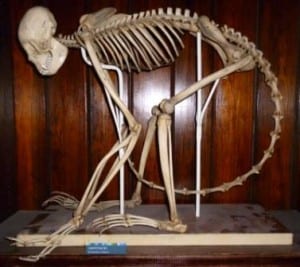Specimen of the Week: Week Fourteen
By Emma-Louise Nicholls, on 16 January 2012
 There has been lots to discover at the museum this week due to a renovation project that saw us decanting nearly a thousand specimens from the wall cabinets and making a mosaic carpet of organisms on the floor in the middle of the museum. (Read more here).
There has been lots to discover at the museum this week due to a renovation project that saw us decanting nearly a thousand specimens from the wall cabinets and making a mosaic carpet of organisms on the floor in the middle of the museum. (Read more here).
The new scenery was a welcome change for most specimens, however there was one left bitter by the whole affair. Normally he enjoys a view of the museum from a high shelf, shared with no-one. Until he was put on the floor. Now I assure you he was placed there with delicate loving care. However, what we neglected to do was face him in the right direction. So instead of a sea of both new and familiar animal faces to amuse him, he had a brown cupboard door, about an inch away from his nose. For two weeks. Whoops.
Feeling bad about this oversight (or subsequent undersight… as it were) I placated him by making him specimen of the week. The specimen of the week therefore is…
***!!!THE SPIDER MONKEY!!!***
1) There are seven species of spider monkey, all of which live in Central and South America and sadly all but one are either endangered or critically endangered.
2) The name ‘spider monkey’ is slightly false advertising given that they are neither small, hairy invertebrates, nor have eight legs. The name is not wholly tenuous however as their tail is prehensile meaning it can grip and essentially be used as a fifth limb. The prehensile nature of the tail, together with the particularly long and spindly arms and legs, give the spider monkey its name.
3) Spider monkeys are not very prolific in the reproductive stakes. Females only normally give birth once every three to four years. In fact, they have one of the slowest reproductive rates of all New World monkeys.
4) Spider monkeys live in what is called a fission-fusion community. This means that large groups of up to 100 individuals will divide up into smaller subsets when feeding, but regroup when it comes to bedtime.
5) Spider monkeys are extremely agile and are able to swing, climb, run along branches, and even walk bipedally (see image left). They have an extremely strong grip (to which I can attest) and can even hang by their tail whilst they use their hands for feeding.
The museum is closed today, please don’t cry, but will reopen tomorrow in a new dawn of shiny glass cabinet doors and strategically placed sparkly lights illuminating even more specimens than you would have ever known were there before. Hoorah!
One Response to “Specimen of the Week: Week Fourteen”
- 1
 Close
Close





[…] makes them easy to distinguish from the ladies. The howler’s tail, as with the spider monkeys that we got to know well before, can be used as a fifth limb for both grip and […]